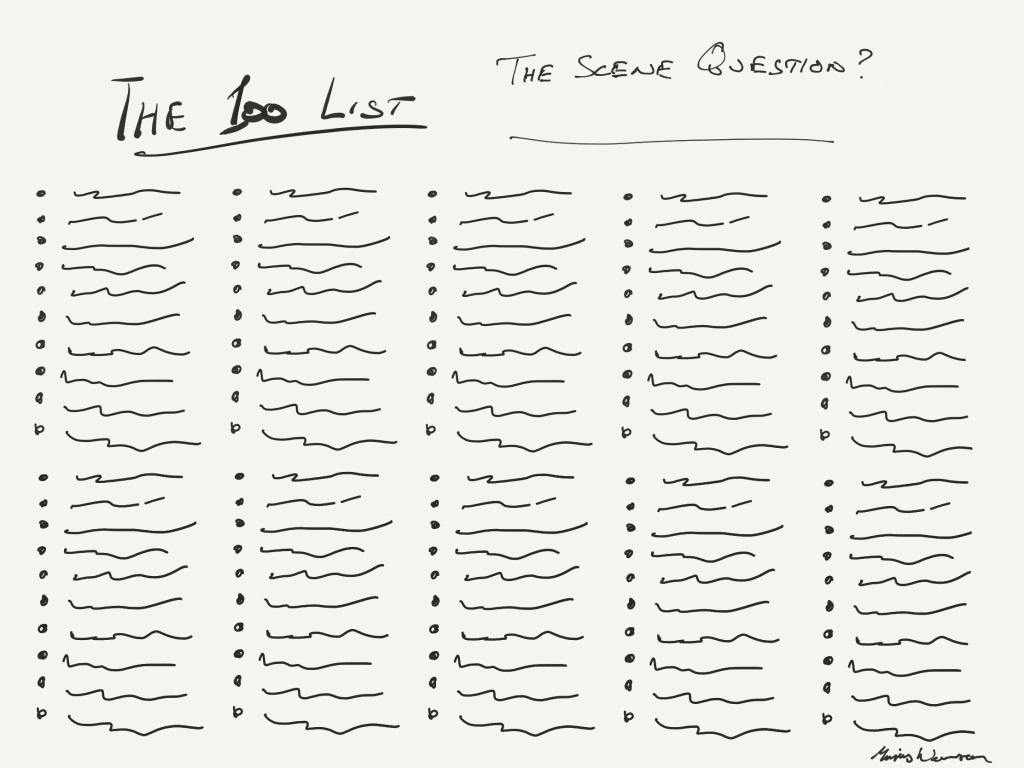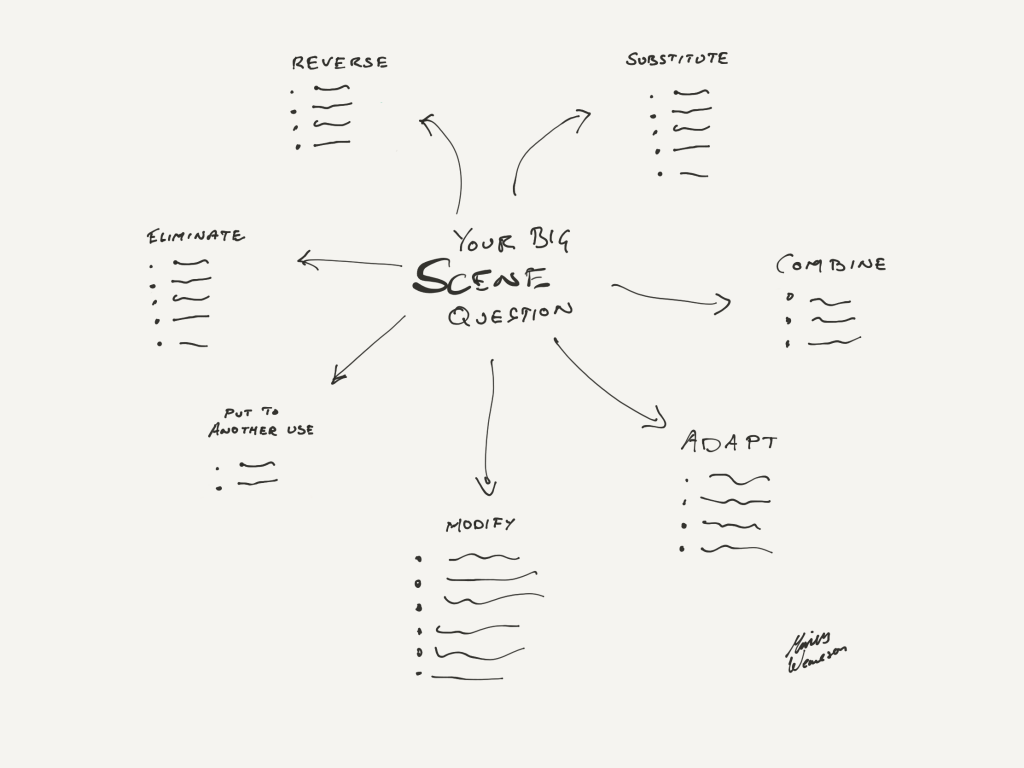Story Grid aficionados find themselves in a predicament daily. The difficulty of being unique while abiding by the conventions and obligatory scenes in writing their masterpiece. Even Shawn recommends you to be novel, in the Story Grid book: “genre craft demands innovation. And that innovation is found in the way a writer handles audience expectations.”
So, how can you escape this predicament and innovate your genre-specific conventions and obligatory scenes?
You don’t have to gloom or become an insomniac to find out the solution to this predicament. It’s all about finding the right framework.
With Story Grid, you have found a framework for telling stories that work. And now, it’s all about discovering the same thing for helping you innovate your writing.
There is a multitude of tools, methods, and systems that help you become more creative and unique with your writing. And when you are stuck with a specific problematic scene, you shouldn’t have to go looking for the right tool.
Here are three tools that I recommend my clients to use, and that I’m going to cover in this article:
- The Top 100 list
- SCAMPER
- Go for a coffee
Top 100 list
The Top 100 list is a tool and technique that helps you uncover 100 different answers and solutions to your stated problem.
The benefit of this method is that it helps you to find unexpected ideas for your problem. It does it by helping you think deeply about the issue.
How should you do it?
To get the benefit from this method, you must get your ideas on paper quickly. And to finish the 100-list in one sitting.
- Start by eliminating distractions
- Put a timer on 24 minutes
- Remember not to worry
Don’t worry about duplicate entries, and don’t evaluate or judge your entries while writing them. You’ll do that at the end by going through your list.
You can expect the outcome from the process to be like the following:
- Your first 30 entries will feature things that are familiar to you. Everything you’ve read and seen so far.
- With your next 40 listings, you’ll start to see emerging patterns and recurring themes. This is “the middle build” of the idea-generating process that will enable you to get to the ending payoff: the next stage.
- The last 30 entries are where you’ll find all the gems, the whacky, and unique ideas. Remember to write down all the whacky ideas you get – this is the gold you’re after.
You can make different 100 lists for each part of the scene. We can use the scene type of “stranger at the door” to illustrate how you can apply the 100 list in your writing.
You can apply the list either to find 100 different types of “stranger” or/and finding 100 places or situations where the scene happens.
To give you an example I’ve chosen “places it can happen on” and only did 15 entries to get you started:
- boat
- house
- telephone
- ufo
- spaceship
- hibernation pod
- tent
- mall
- gas station
- car
- shower
- restroom
- letter
- bootle
- restaurant
I think you’ll recognize some of these situations in different movies.

You can also use the 100-list method to find a character’s motivation in the scene. Where- and whenever you get stuck with your writing, you can apply the 100-list method to get out of your predicament.
If you are having a hard time coming up with your 100-list, you can always combine it with the next tool.
SCAMPER it out
SCAMPER is a technique for developing and improving your imagination skills, to think creatively about a problem and ideas. Author Bob Eberle introduced the method in his book Scamper: Games for Imagination Development.
SCAMPER is an acronym, and also a form of mnemonic. When you feel stuck with a scene or want ways to improve existing ones, you only have to remember to SCAMPER it out.
The tool helps you explore scene ideas from seven different areas: Substitute, Combine, Adapt, Modify, Put to another use, Eliminate, Reverse.
To give you some examples of questions you can use for each area in SCAMPER:
- Substitute: What in the scene can you replace with something else?
- Combine: What in the scene can you combine to make something new? Or can you combine two different scenes?
- Adapt: What can you add to the scene to enhance it? Can you adapt the feeling and mood of the scene?
- Modify: What can you modify in the scene? E.g., What can be minified or magnified?
- Put to another use: Is there something in the scene that you can use in another way?
- Eliminate: What can you eliminate, simplified, or removed from the scene?
- Reverse: What can you rearrange, redefine, or flip in the scene? What would happen if you reversed the polarity in the scene from a positive to a negative?
How to use the SCAMPER method
Start by identifying what in the scene you’re going to apply the technique on. Or you can choose to apply the method on the whole scene. Whatever you choose, be sure to write it in the middle of a blank paper.
The next step is to go through each area of SCAMPER and ask the questions to guide your thinking. Try to come up with 5 to 7 things for each of the areas.
After you have gone through all of the seven sections, you can evaluate your notes. Evaluate them based on the uniqueness and wackiness.

I’m confident that you’ll find something unique that you can use in your rewrite of the scene. And in this way, you’ll avoid writing cliches.
As I mentioned in the previous method, you can combine the 100-list with SCAMPER. And you can do it in two different ways:
- You can come up with 15 things for each area in SCAMPER, and you’ll end up with 105 things to uniquely make a scene.
- Or you can make a 100-list of each area. E.g., write 100 substitutions for the murder weapon.
But sometimes, the only thing that might get you unstuck is asking a friend out for a coffee.
Ask a friend for coffee
Asking a friend out for a coffee is all about having conversations around a specific scene where you’re stuck.
It’s a great way to get a fresh perspective. And you get access to your friend’s life experience.
There are three ways you can do this, and all of them have different cons and pros:
- Talk it with a non-writing friend who is an avid reader, preferably in the genre you’re writing in but not necessary. It’s a great way to get feedback from a reader.
- If you are a part of a writing group, use your fellow writer friends to get feedback, tips, and improvements on the scene in question.
- Or, if you have the possibility, I would recommend that you hire one of us Certified Story Grid Editors that specializes in your genre.
Whatever type of friend you end up asking out for coffee, it will be the right choice. Don’t overthink it. If you need help, just ask a friend for help. Listen to feedback, and then get back to writing your masterpiece.
Benefits of using these methods
By using the methods and tools mentioned in this article, you’ll improve your writing. The methods and tools help you think creatively and avoid writer’s block.
You’ll write scenes that are different and surprising. You will write with confidence because you know how to avoid cliches in your writing.
You will only get the benefits promised by implementing and testing the methods for yourself.
I know you’ll do that because you are here, reading the Story Grid articles because you want to improve your storytelling and writing craft.
Innovate your scenes by using the methods mentioned in the article. Try them out and let me know what your results are by commenting below.